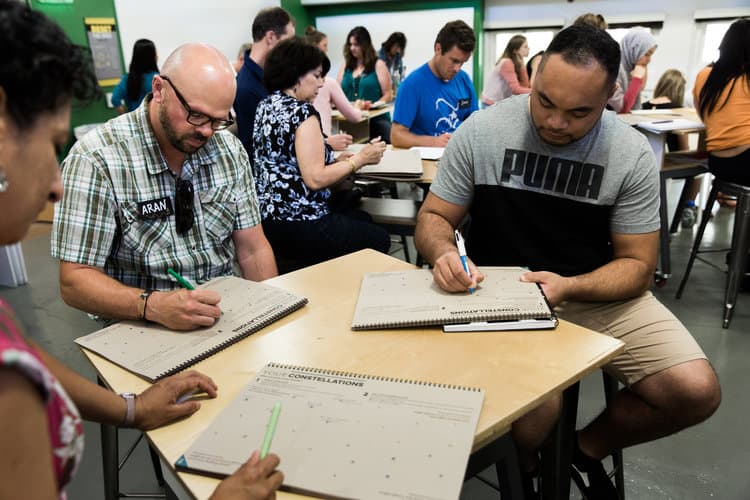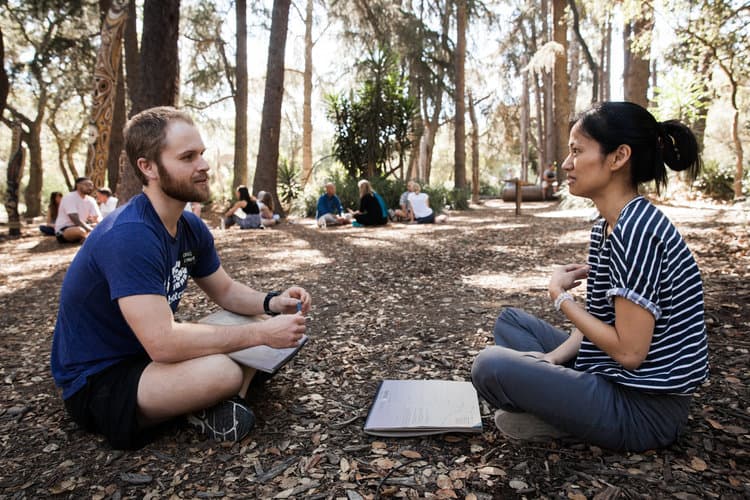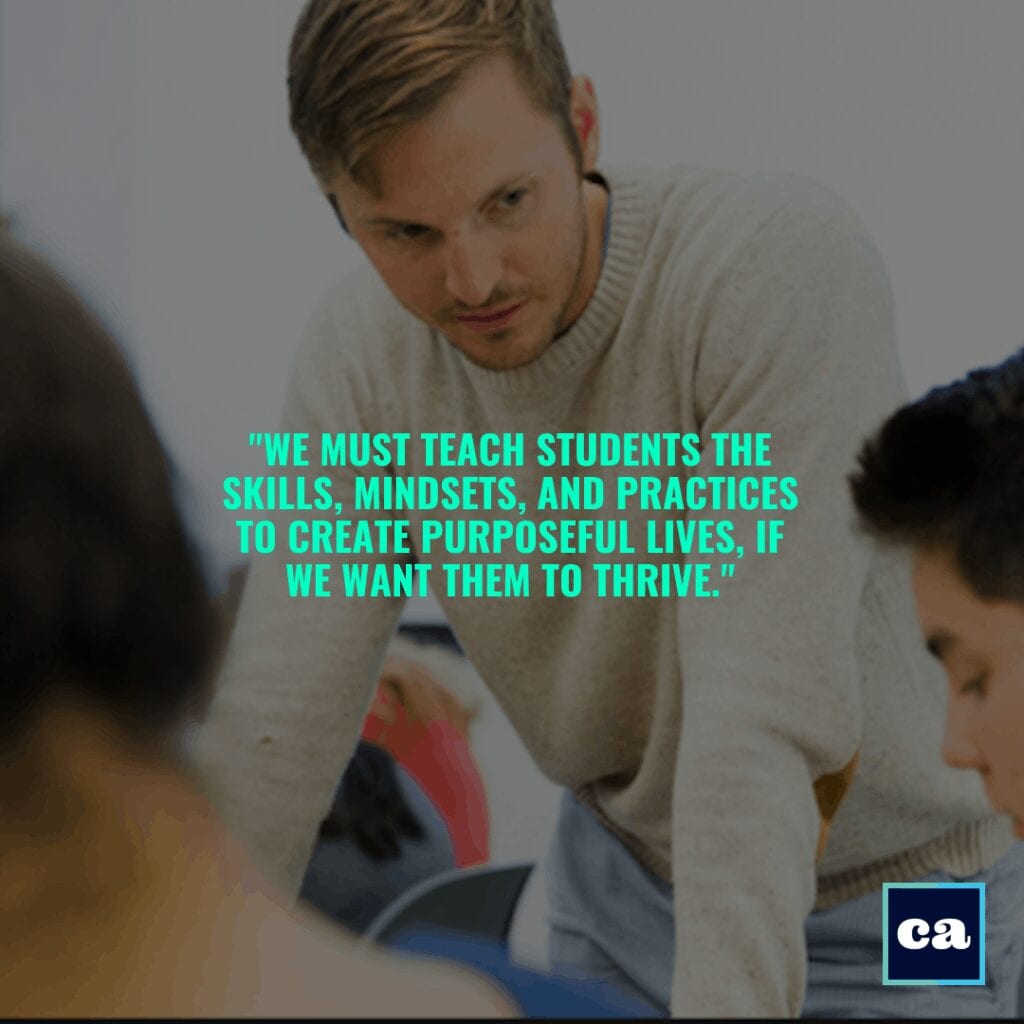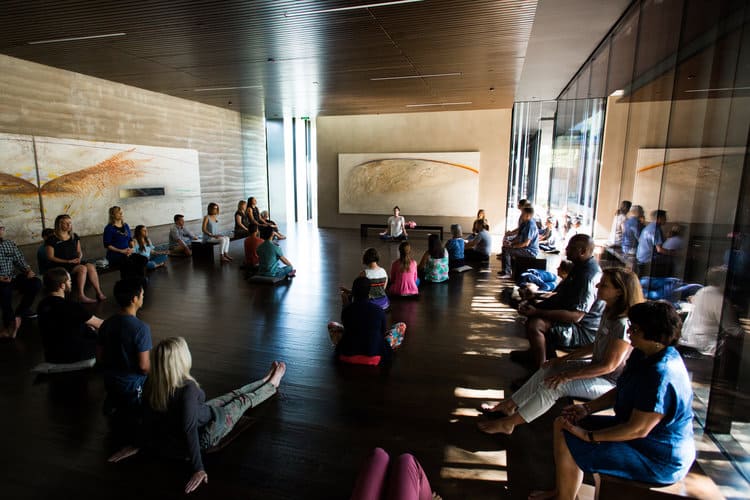Last month, I was talking to an experienced educator about Project Wayfinder, the high school curriculum I’ve developed to help students create a meaningful life. It’s a curriculum that brings together the best of the biggest innovations in secondary and higher ed, incorporating elements of social-emotional learning (SEL), mindfulness education, project-based learning, and design thinking.

As I explained what we do, the educator cut me off: “Great, but how do the students respond to it?” She asked. “Do they actually like it?”
In a word, yes. Since teaching my first mindfulness class eight years ago, I have seen the power of mindfulness and social-emotional learning (SEL) transform the lives of high schoolers. Research has since confirmed those observations, showing that SEL high school programs lead to a more positive and caring school climates while inspiring students to be more engaged in school as they develop a growth mindset, place more value on helping others in their community, and help them generate more ambitious goals for their pursuits in higher education.
However, I saw something missing. SEL and mindfulness classes on their own fail to connect students’ inner development to their real-world projects and concerns. My students often told me that while well-taught and designed SEL and mindfulness skills were useful, they felt divorced from the pressing decisions they face, decisions like what to do after high school, what college to attend, what kind of career to pursue, and of course the biggest question of all: “What do I want to do with my life?”
Five years ago, I started developing Project Wayfinder to bridge the internal world of SEL with the external world of real-life decision making. As it turned out, I wasn’t the only one; educators in different corners of the country were simultaneously working to solve the same problem.
Along with Project Wayfinder, a number of purpose-development organizations have sprung up, including the Future Project, the QUESTions Project, NxU, Transcend Education, and Noble Impact. Together, these organizations are developing a new field of Purpose Learning at the high school level.
Many of these organizations use a definition of purpose by Stanford’s Dr. Bill Damon, a leading expert on youth purpose development:
“Purpose is a long-term, forward thinking intention that is both meaningful to the self and consequential to the world.”
Dr. Bill Damon – Professor – STANFORD UNIVERSITY
In other words, for something to be purposeful you have to care about it and it has to have a positive impact in the world bigger than yourself.
The desire to translate the value of SEL and mindfulness education to real world applications makes sense. Students are entering a totally different job market than the one our current high school model was designed to prepare them for.
No longer will students occupy a single line of employment over a lifetime. And soon, nearly 50% of U.S. workers will be contracted laborers. That means students must to learn to be nimble, creative, relationship-builders able to set themselves up for a series of meaningful, varied projects over the course of a lifetime.

Purpose Learning aims to equip students with these skills. We seek to empower students to create their own meaningful projects, develop relationships with mentors and future work-partners, and navigate the feelings of ambiguity and distress that naturally arise as we strike out in the world. More than ever, students need our help and guidance to develop the emotional intelligence, empathy, and curiosity towards teammates valued by culture-setting employers like Google.
Of course, there are many ways to slice this. Each of the Purpose Learning organizations noted above has taken a different approach to how they help students develop purpose.
For example, Noble Impact uses both teacher PD and curriculum to help schools grow a culture of trust and innovation, the Future Project inserts a “dream director” directly into schools to help students craft purpose projects, NxU has experiential summer programming combined with year round mentoring, and Transcend Education works on new school models that incorporate purpose as a core pillar.
Project Wayfinder has developed a yearlong signature purpose learning curriculum for high school students. While each program takes its own unique tack, all share a common goal: to help students grow into purposeful, meaning-making humans.
Many of these organizations focus on the teacher training and the development that goes into delivering impactful curriculum: for teachers to teach about meaning and purpose, they have to spend the time exploring and articulating their own.

Or, as Heather Malin of Stanford says in Teaching for Purpose, her book on Purpose Learning: “Regardless of whether these programs sought teachers with ideal qualities for teaching purpose, they all said that teacher training is vital to program success.” This is of course similar to the course mindfulness teacher training has taken – it’s essential that educators teaching mindfulness have their own mindfulness practice too.
Increasingly, teachers and educators are thirsty for an antidote to students’ boredom in the classroom, their inability to see meaning in their education, and severe anxiety about their futures.
Project Wayfinder is now working with 4000 students at 55 schools in 12 countries in only our second year of implementation. And in only a few years, the Future Project has installed Dream Directors at more than 50 schools with principals clambering for more.

The current state of Purpose Learning reminds me of where mindfulness and design education were about a decade ago — right on the cusp of a huge breaking wave. My big hope is to see the purpose education movement gain power and steam over the coming decade to become a cornerstone of adolescent education.
In an increasingly unpredictable and self-defined world, this much is clear: we must teach students the skills, mindsets, and practices to create purposeful lives, if we want them to thrive.
Listen to Causeartist podcasts here.




